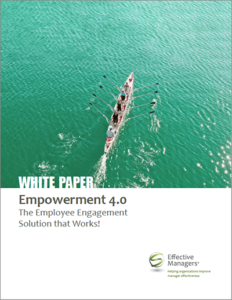
What business owners might find surprising is that the cause for it often lies in management and leadership. Inspiring high levels of engagement seems like an impossible task if you don’t have the right people in management positions. However, it’s still possible to learn how to improve in this regard. Here’s why employee engagement is important, and some of the practices you should strive to implement:
The Importance of Employee Engagement
Employees constantly reevaluate their experience at work and their decision to stay at their job. And according to the research of Mental Health America and the Faas Foundation, 71% of employees are unhappy at their current situation and looking for new job opportunities.
Consider these facts from Gallup when comparing companies with engaged employees in the top quartile vs those int the bottom quartile:
- Engaged employees have 48% FEWER safety incidents
- There are 41% LESS quality incidents
- Absenteeism is 43% LOWER
- Customer ratings are 10% HIGHER
- Productivity is 21% HIGHER
- Profitability is 22% HIGHER
Judging from these statistics, employee engagement is a rare treasure, and one that has serious consequences if not found. Replacing employees is not cheap, which makes it all the more important to ensure your employees are happy. Some organizations manage to do it — How?
How Bad Management and Leadership Affects Loyalty
Unfortunately, when management and leadership within an organization are ineffective, one of the expected consequences is a lack of employee engagement. There can be many reasons why an organization’s management would fail to keep employees happy. Some of the typical suspects are a lack of accountability, micromanagement of employees, and lack of feedback loops.
All of these make employees feel like their managers don’t trust them to do their job well and don’t value their opinion. In those circumstances, why would any employee stay longer than it would take them to find a new job opportunity? Bad managers and ineffective leadership can have an enormous toll on the organization, and these practices can devoid it of any significant success. For an employee, that can be just another reason to leave — their contributions feel meaningless.
Improving Employee Engagement
To improve employee engagement, an organization has to change from the top levels. Especially when it comes to accountability, it’s crucial for the leadership to recognize what they should be doing to keep the employee turnover rates low. And what they can do is ensure that their organization operates by the principles of clear accountability, set by excellent communication within the organization.
Effective delegation of work ensures that every employee knows their task and that they have the means to complete it. In addition to that, it’s essential to improve communication, between different organizational levels as well as between individuals within the same organizational levels. Following these principles can get an organization out of many various problems, employee engagement being only one of them. It’s a solution that would fix the cause of the problem as opposed to its consequences.
Key Takeaways
Employee engagement is one of the pillars of a successful organization. As such, you have to make sure that your management is up to the task of maintaining it. With Effective Point of Accountability, you’ll put the right principles into practice and ensure that your employees wish to stay.

Download a complimentary copy here: Empowerment 4.0 Whitepaper
Dwight is leading a 7-week Flevy Executive Learning (FEL) program on effective management called Empowerment 4.0, as well as giving a free webinar by the same title. Sign up for the webinar here.
Check out our YouTube channel for free VidCasts and recorded Webinars.







